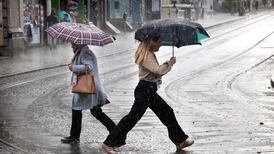ONCE again, there were conflicting views of the first of the higher level maths papers yesterday.
Some students and their parents complained of the difficulties experienced with the paper, while teachers in general appeared to find the paper no more difficult than might be expected at this level.
One Co Wicklow parent telephoned Exam Times to say that her daughter was "absolutely devastated" following the examination. "It was very difficult and very disheartening for her, and she would have been quite confident about maths," she said.
The number of students taking higher level maths has been on the increase since the introduction of the revised maths papers in 1994. These were highly praised in their introductory year but attracted a mixed reception from students and teachers last year.
"I think students have expectations that they should have seen everything on the paper before" said Mr John Evans, a TUI course committee representative and a teacher in Mount Temple Comprehensive School, Malahide, Co Dublin.
"That is not the case. You teach for understanding, not mechanical reproduction," he said.
Mr Evans suggested that the atmosphere fostered by some grind schools prompts the belief that students can be prepared for everything. This might lead students to misunderstand the nature of the examination, he said.
"With part (c), the students will not have seen the questions before. The whole point is that they are not supposed to have seen it before, but, given the background of knowledge they have of the syllabus, they should be able to do it," Mr Evans said.
He stressed that students should not be anxious and that those who had worked hard and prepared for the examination would perform satisfactorily.
Mr Evans said that his students were "very busy" with the volume of work presented but that some were able to attempt seven questions. "The first three questions were grand for them. Thereafter, in questions 4 to 8, the (a) sections and (b) sections were grand and the (c)s were very testing."
Mr Sean O'Brien, ASTI subject representative and a teacher in CBS Secondary School, Tralee, Co Kerry, said that overall the higher level paper was reasonable, but required all the time allowed to complete it.
He noted testing parts in the calculus questions (questions 6 to 8), which he said could have an impact on the achievement of higher grades.
Ms Deirdre Quin, a teacher in Park College, Galway, said her students were very happy with the higher level paper.
"Higher level maths was often perceived as the big undo able, so they've tried to make it more approachable," Ms Quin said. She noted that the problem solving aspect has been generally limited to the final part of each question.
Question 5(c), though, may well have seemed like a godsend to many students, since it was a straightforward proof taking about five lines to complete, she commented.
Question 6(b)(ii), meanwhile, involved the Newton Raphson method, which come up some what unexpectedly last year but was repeated this year in a similar format to last year and was very straightforward, in Ms Quin's judgment.
"There were a lot of standard questions in other words, questions they would have tackled in school," she concluded, though she noted that the paper was "bitty" in the sense that many questions included large numbers of subordinate parts.
It was a complaint echoed by Mr Mark O'Riordan, a student in Presentation College, Bray, Co Wicklow, who had contacted the Department of Education after the exam to express his views. "The general feeling was that we could have done the questions if we'd had the time," he said. "There were just too many questions."
Students will not have been helped by the fact that question 8 was not numbered on the examination paper, giving the possible impression that question 7 had 11 constituent parts.
Some ordinary level students were also unhappy with the examiners' efforts to test their mathematical knowledge yesterday, with Paper 1 proving unpopular with some students who felt that the format and notation used differed from previous years.
"It was disastrous," said Ms Caitriona Kerrie, a student in Muckross Park, Donnybrook, Dublin. "It was not like last year's paper, or a 1974 paper. It was a horrible paper.
Teachers were generally more circumspect in their views. "A lot of the time, with maths questions, it's not what they ask but how they ask it," Ms Quin said. "The questions were probably asked in a more difficult way this year."
The function notation on the paper might have proved intimidating to the weaker student, particularly questions 6 and 8, Ms Quin said. The co-ordinate geometry section of question 6 might have been unexpected, she said. "Overall, it was probably a little harder than Last year's paper, with more twists.
Ms Bernie Chambers, a teacher in Bray Institute of Further Education, Co Wicklow, said that the paper had received a "mixed reaction" from students, but that overall they were happy with it. She did not feel that the paper differed excessively from previous years.
"It was a challenging paper but straightforward in many respects," she said.
"Question 1 was a nice lead in to the paper. Solving cubic equations and functional equations was due an airing and came up this year," she added.
Ms Chambers identified tricky parts in some questions, notably 6(b), 8(b)(iv) and 3(c), where students might have found it difficult to to figure out what they were being asked to do, but there were also some parts which were similar to previous years.
Mr O'Brien described the paper as similar to other years. The alternative level paper was "standard", he said.







